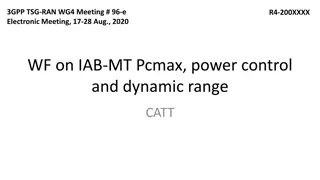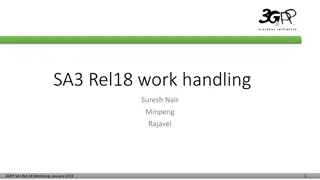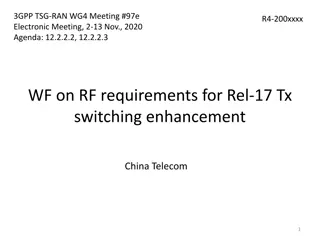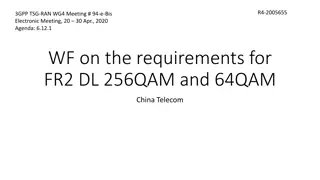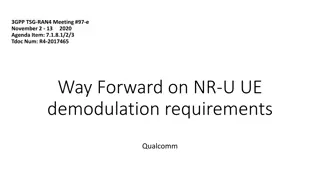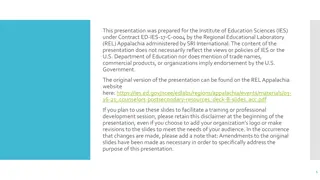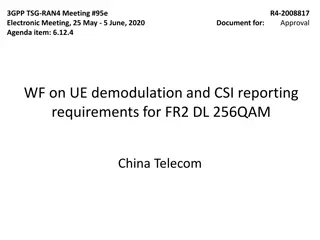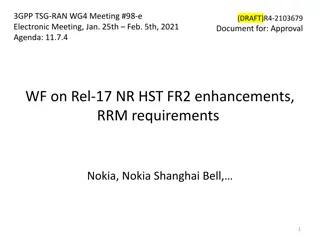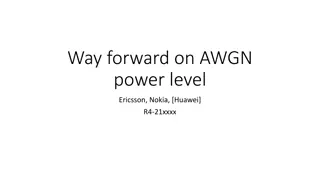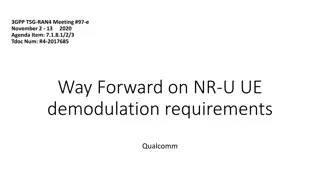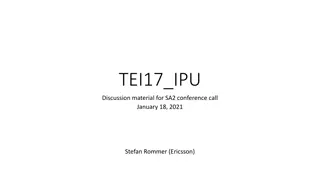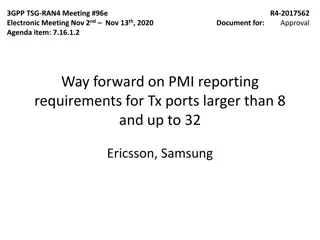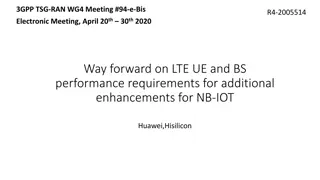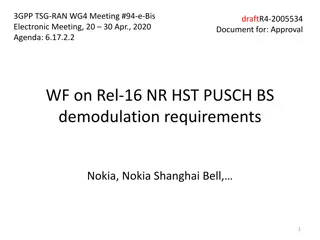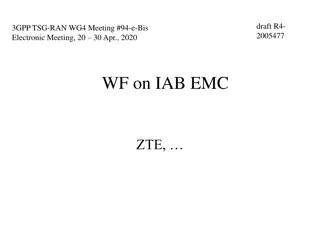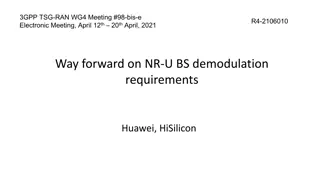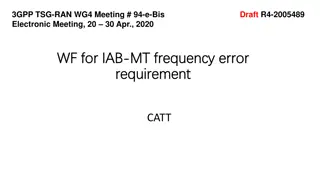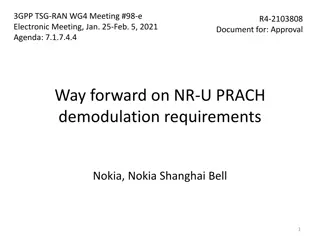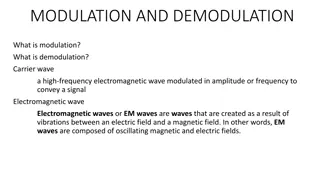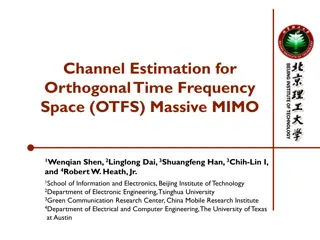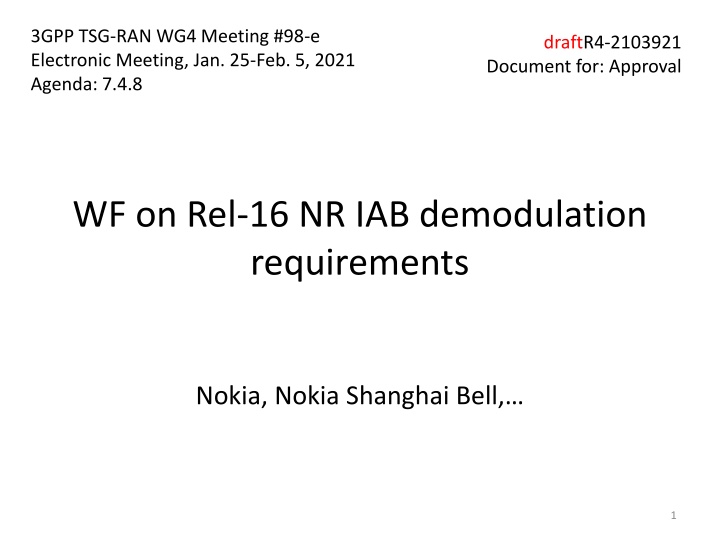
Meeting #98-e Agenda: Approval WF on Rel-16 NR IAB Demodulation Requirements
"Discover the agenda for the electronic meeting of 3GPP TSG-RAN WG4 Meeting #98-e, focusing on the approval of the WF on Rel-16 NR IAB demodulation requirements by Nokia and Nokia Shanghai Bell."
Download Presentation

Please find below an Image/Link to download the presentation.
The content on the website is provided AS IS for your information and personal use only. It may not be sold, licensed, or shared on other websites without obtaining consent from the author. If you encounter any issues during the download, it is possible that the publisher has removed the file from their server.
You are allowed to download the files provided on this website for personal or commercial use, subject to the condition that they are used lawfully. All files are the property of their respective owners.
The content on the website is provided AS IS for your information and personal use only. It may not be sold, licensed, or shared on other websites without obtaining consent from the author.
E N D
Presentation Transcript
3GPP TSG-RAN WG4 Meeting #98-e Electronic Meeting, Jan. 25-Feb. 5, 2021 Agenda: 7.4.8 draftR4-2103921 Document for: Approval WF on Rel-16 NR IAB demodulation requirements Nokia, Nokia Shanghai Bell, 1
Background The following WFs were approved previously R4-2012644, WF on Rel-16 NR IAB demodulation requirements, RAN4#96-e. R4-2017673, WF on Rel-16 NR IAB demodulation requirements, RAN4#97-e. Corresponding Email summary in RAN4#98-e R4-2103935, Email discussion summary for [98e][320] NR_IAB_Demod. 2
General - DraftCR, bigCR, and bigTP work split (I) Company Huawei IAB demodulation draftCR, bigCR, and bigTP work-splits - TS 38.174 TS 38.174 bigCR Demod TS 38.174 Performance requirements (draftCRs) 8 Conducted performance requirements IAB-DU performance requirements General, PUSCH FR1, PUCCH FR1, PRACH FR1 IAB-MT performance requirements General (all excluding radiated) Demodulation (Conducted requirements/FR1) General (incl. applicability, etc), PDSCH, PDCCH, PBCH, SDR, SDR CA CSI reporting (Conducted requirements/FR1) General, CQI, PMI, RI Demod for interworking (verification in FR1) CSI reporting for interworking (verification in FR1) 11 Radiated performance requirements IAB-DU performance requirements General, PUSCH FR1&FR2, PUCCH FR1&FR2, PRACH FR1&FR2 IAB-MT performance requirements General (all excluding conducted) Demodulation (Radiated requirements/FR2) General (incl. applicability, etc), PDSCH, PDCCH, PBCH, SDR, SDR CA CSI reporting (Radiated requirements/FR2) General, CQI, PMI, RI Demod for interworking (verification in FR2) CSI reporting for interworking (verification in FR2) Appendix Ericsson Huawei Intel Intel Intel Ericsson FRCs/RMCs, PRACH Test preambles, etc. [Note: MT setup/connection/environment/etc. included in ???-1/2.] Ericsson 3
General - DraftCR, bigCR, and bigTP work split (II) Company Intel IAB demodulation draftCR, bigCR, and bigTP work-splits - TS 38.???-1 TS 38.???-1 bigTR Demod TS 38.???-1 Conducted conformance testing (draftCRs) Manufacturer declarations 8 Conducted performance characteristics IAB-DU performance requirements General (incl. applicability rule), PUSCH FR1, PUCCH FR1, PRACH FR1 IAB-MT performance requirements General (all excluding radiated) Demodulation (Conducted requirements/FR1) General (incl. applicability, etc), PDSCH, PDCCH, PBCH, SDR, SDR CA CSI reporting (Conducted requirements/FR1) General, CQI, PMI, RI Demod for interworking (verification in FR1) CSI reporting for interworking (verification in FR1) Appendix FRCs/RMCs & PRACH Test preambles Rest (incl. test setup/TT/etc.) Huawei Nokia Ericsson Huawei Intel Ericsson 4
General - DraftCR, bigCR, and bigTP work split (III) Company Nokia IAB demodulation draftCR, bigCR, and bigTP work-splits - TS 38.???-2 TS 38.???-2 bigTR Demod TS 38.???-2 Radiated conformance testing (draftCRs) Manufacturer declarations 8 Radiated performance requirements IAB-DU performance requirements General (incl. applicability rule), PUSCH FR1&FR2, PUCCH FR1&FR2, PRACH FR1&FR2 IAB-MT performance requirements General (all excluding conducted) Demodulation (Radiated requirements/FR2) General (incl. applicability, etc), PDSCH, PDCCH, PBCH, SDR, SDR CA CSI reporting (Radiated requirements/FR2) General, CQI, PMI, RI Demod for interworking (verification in FR2) CSI reporting for interworking (verification in FR2) Appendix FRCs/RMCs & PRACH Test preambles Rest (incl. test setup/TT/etc.) Intel Nokia Huawei Ericsson Huawei Nokia 5
IAB-DU - General Carrier aggregation Follow Rel-15 approach and include notes that CA can be operated and is tested per carrier. 6
IAB-DU - PUSCH Rel-16 fixes to Rel-15 BS demodulation requirements For IAB-DU 16QAM 2T2R radiated test cases reuse BS performance requirements with Rel-16 fixes. Channel model All existing channel models used in Rel-15 BS testing should be re-used (including TDLB100-400 for FR1). MCS Include requirements for QPSK, 16QAM (and declaration of support). Add applicability rule that highest modulation order is tested only with lowest supported SCS and other modulation orders only with highest supported SCS. UCI multiplexed on PUSCH All existing requirements for UCI multiplexed on PUSCH should be re-used. Applicability rule on SCS Combine existing applicability rule for tested SCS with newly proposed one for MCS. Applicability rule on CBW Use existing applicability rule for CBW. Applicability rule on mapping type Use existing applicability rule for mapping type 7
IAB-DU - PUSCH Requirements with 30% max TPUT Option 1: All existing requirements for PUSCH with 30% of maximum throughput should be re-used for IAB-DU. Option 2: Keep prior agreement. Do not include 30% TPUT requirements for IAB-DU. Tentative agreement: Agree on option 2. (Consensus in 2ndround.) Transform precoding Option 2: Re-use only requirements for PUSCH with transform precoding disabled. Option 3: Include requirements, create a manufacture declaration to allow dft-s-OFDM support, and add applicability rule to only test, if dft-s-OFDM is supported. 8
IAB-DU - PUCCH Channel model All existing channel models used in Rel-15 BS testing should be re-used. Multi-slot Option 1: Include multi-slot PUCCH cases and keep existing BS demodulation-based test applicability rule ( multi-slot PUCCH requirement tests shall apply only if the BS supports it ). Option 2: Skip cases for multi-slot PUCCH. 9
IAB-DU - PUCCH Applicability rule on number of test cases and formats Option 5: Keep all the PUCCH requirements and related test applicability rule. Possibility to not declare support, which means no test. Option 6a: Keep all PUCCH formats in the requirements from BS, and formulate an applicability rule as If one PUCCH format and more than one SCS are supported, test the PUCCH format with both SCS. If more than one PUCCH format and one SCS are supported, test any one format /two formats chosen by the manufacturer. If more than one PUCCH format and more than one SCS are supported, ensure that all SCS are tested with at least one PUCCH format chosen by the manufacturer. Option 6b: Keep all PUCCH formats in the requirements from BS, and formulate an applicability rule as If one PUCCH format and more than one SCS are supported, test the PUCCH format with both SCS. If more than one PUCCH format and one SCS are supported, test any one format /two formats chosen by the manufacturer. If more than one PUCCH format and more than one SCS are supported, ensure that each declared SCS is tested with one PUCCH format chosen by the manufacturer. Option 6c: Keep all PUCCH formats in the requirements from BS, and formulate an applicability rule as If one PUCCH format and more than one SCS are supported, test the PUCCH format with all SCS. If more than one PUCCH format and one SCS are supported, test any two formats chosen by the manufacturer. If more than one PUCCH format and more than one SCS are supported, ensure that all SCS are tested with at least one PUCCH format chosen by the manufacturer. Option 6d: Keep all PUCCH formats in the requirements from BS, and formulate an applicability rule as If one PUCCH format and more than one SCS are supported, test the PUCCH format with all SCS. If more than one PUCCH format and one SCS are supported, test any two formats chosen by the manufacturer. If more than one PUCCH format and more than one SCS are supported, ensure that each declared SCS is tested with one different PUCCH format chosen by the manufacturer. 10
IAB-DU - PRACH Channel model All existing channel models used in Rel-15 BS testing should be re-used, except for AWGN (i.e., fading case only). Formats to include in specification Option 1: Keep only typical preamble formats selected by companies. Option 2: Only keep requirements for PRACH formats that infrastructure manufacturers plan to implement/configure in IAB-nodes, but at least formats 0, A2, C0 and C2. Option 3: Copy all requirements for all PRACH formats. Vendor can declare which ones are supported/tested. Applicability rule for formats Option 3: All existing requirements and applicability rules for PRACH should be re-used for IAB-DU and corresponding declaration on supporting of this feature should be defined. The following new one applicability rule should be added: For IAB-DU declares to support more than one PRACH formats, limit the number of tests to any two cases chosen by the manufacturer. If IAB-DU declares to support more than one PRACH formats where formats for both long and short PRACH sequences are presented, require to chose formats with different sequences. Option 4: If a format is declared to be supported then it should be tested. It should of course be possible to not declare support for (and hence not test) formats. 11
IAB-MT - Conformance testing setup Basis for test setup (from GtW) Test setup and performance requirements based on the BS approach assumption, i.e., using a signal generator and assuming unidirectional Uu interface. Flexibility in connection/test setup is allowed by keeping the specified setup informative. Further work on the texts to specification to align with RF conformance test assumption. Synchronization in test procedure (from GtW) Write the test procedure using the BS approach, i.e., no detailed synchronization configuration for synchronization is included in conformance specifications. Add a note in conformance specifications to clarify that IAB-MT synchronization with the TE is left to implementation, i.e., neither the use of DL signal configuration nor the use of proprietary means is precluded. In tests performed with signal generators, a synchronization signal may be provided between the IAB node and the signal generator, or a common (e.g., GNSS) source may be provided to both IAB node and the signal generator, to enable correct timing of the wanted signal. 12
IAB-MT - Conformance testing setup Synchronization configuration Option 1: Provide DM-RS for fine synchronization. Optionally, TRS can also be transmitted during the test for fine synchronization. Option 2: Agreement on this matter is not required. HARQ Feedback Note in BS specification can be reused: The HARQ Feedback could be done as an RF feedback or as a digital feedback. The HARQ Feedback should be error free. L1/L2 testing mode Up to implementation. Only keep prior agreements. 13
IAB-MT - General Reference channels Demodulation requirements are defined based on single-slot FRCs. FFS: How to reuse existing requirements and configuration, since for UE requirements PDSCHs with different effective code-rates were accumulated for total statistic. Option 2: PDSCH is scheduled only on D slots without CSI-RS resource and TRS allocated. Other options not precluded. Tentative agreement: Agree on option 2 and remove FFS. (Consensus in 2ndround.) TDD pattern (from GtW) Reuse default TDD UL-DL pattern from BS requirements for IAB MT requirements definition (60, 120 kHz SCS: 3D1S1U, S=10D:2G:2U; 30 kHz SCS: 7D1S2U, S=6D:4G:4U) and the same requirements are applicable to TDD with different UL-DL patterns. The SNR of achieving PDSCH relative throughput (e.g. 70%) can be independent on the slot configuration. 14
IAB-MT - General Reference signals in test parameters and reference channels No need to specify SSB, TRS, CSI-RS in the test parameters and FRCs. FFS: Configurations for SSB, TRS, CSI-RS can be defined. Option 3: Configurations for SSB, TRS, CSI-RS can be defined, and they can be transmitted if deemed needed during the test by the IAB manufacturer. Option 4: Configurations for SSB, TRS, CSI-RS do not need to be defined, they are left open to implementation. Tentative agreement Add note in specification that transmission of SSB, TRS, CSI-RS is not precluded. Remove FFS. 15
IAB-MT - General Down scoping and changing of propagation conditions (from GtW) RAN4 realized removing the test cases for TDLC300-100 in FR1 and TDLA30-300 (Low and medium) in FR2 will bring test coverage issues since some features only verified by these channel models, RAN4 will further discuss the solution to address test coverage issue with candidate options as following: Option 1: Keep propagation conditions TDLC300-100 in FR1 and TDLA30-300 (Low and medium) in FR2. Option 2: Replace the channel model of the test cases corresponding to TDLC300-100 in FR1 and TDLA30-300 (Low and medium) in FR2 with following candidate channel model: TDLA30-10 (Low) for FR1 and TDLA30-75 (Low) for FR2 Companies who support option 2 need to provide a plan how to ensure we can complete the work with manageable simulation effort in time. 16
IAB-MT - General Basis for requirement re-use Discuss which configurations to keep/remove on a case by case basis. MT types and classes Option 1: For most of cases, the same requirements apply for all classes. For other cases, if companies think applicability rule can be defined for different classes, discuss them case by case. Option 2: Other options not precluded. Tentative agreement Remove this issue from the WF. Only comment received in this meeting is do not see a strong need in this agreement . Conducted and radiated testing IAB type 1-O radiated requirements shall be defined. FFS: Further constraints Option 1: IAB type 1-O radiated requirements shall be defined for all 2Rx and 1Rx. Option 2: Define IAB type 1-O radiated requirements with 2Rx. Tentative agreement Option 2: Define IAB type 1-O radiated requirements with 2Rx. (Consensus in 2ndround.) 17
IAB-MT - PDSCH MCS (from GtW) 16QAM and 256QAM (FR1 only) need to be covered. The supporting of 256QAM requirements should be declaration basis. The supporting of 256QAM requirements based on the assumption of 256QAM supporting for 1-O is testable Further checking 256QAM supporting for 1-O considering test link-budget issue. Rel-16 MCS (from GtW) Keep prior agreements that do not include any Rel-16 UE demod requirements Mapping type Only keep PDSCH performance requirements for mapping Type-A. PRB bundling size Option 1: Change prior agreement: Only keep requirements with wideband PRB bundling size and PRB bundling size 2. Option 2: Keep prior agreements that only keep requirements with PRB bundling size 2. Tentative agreement: Since the inclusion of 16QAM was agreed, keep prior agreements, i.e., option 2. 18
IAB-MT - PDSCH Enhanced Receiver Skip PDSCH cases for enhanced receiver Type 1. Definition of such requirements in future releases is not precluded. Overlapped CSI-RS Skip PDSCH cases for CSI-RS overlapped with PDSCH. Co-existence with LTE CRS Skip PDSCH cases for co-existence with LTE CRS, as they are only defined for FDD. Test parameters specification simplification Do not specify the following parameters in IAB-MT PDSCH test configurations and leave them up to implementation: SSB, PDCCH configuration, CSI-RS for tracking, ZP CSI-RS. FFS: Clarify what remove/not specify and leave up to implementation means in terms of capturing in the specification. Option 1: Keep the corresponding rows in specification tables and mark up to implementation . Option 2: Remove the corresponding rows in specification tables. Option 3: Other options not precluded. Tentative agreement: Option 2. Have note in specification as transmission of SSB, TRS, CSI-RS is not precluded. 19
IAB-MT - PDCCH Aggregation Level (from GtW) Include all TDD PDCCH requirements except for AL 16. Test parameter specification simplification Follow tentative agreement from IAB-MT General, Test parameter specification simplification: No need to specify SSB, TRS, CSI-RS in the test parameters and FRCs. FFS: Configurations for SSB, TRS, CSI-RS can be defined. Tentative agreement Follow PDSCH - Test parameters specification simplification agreement. Propagation condition (from GtW) Apply same approach as PDSCH. Test coverage of SCS Not include 15kHz SCS requirements for all cases. 20
IAB-MT - PBCH Inclusion of PBCH Option 1: Reuse UE PBCH requirements for IAB-MT node. Option 2: Do not introduce PBCH requirements for IAB-MT. Option 3: Re-use and test the TDD UE demodulation minimum performance requirements for the case of SS/PBCH block index is known . Skip the cases of unknown index. Tentative agreement Agree on option 2 (consensus in second round). 21
IAB-MT - SDR Inclusion of SDR Do not include SDR requirements for the IAB-MT 22
IAB-MT - CSI Reporting Test parameter specification simplification Follow tentative agreement from IAB-MT General, Test parameter specification simplification: No need to specify SSB, TRS, CSI-RS in the test parameters and FRCs. FFS: Configurations for SSB, TRS, CSI-RS can be defined. Tentative agreement Follow PDSCH - Test parameters specification simplification agreement. 23
IAB-MT - CSI Reporting CQI inclusion Include CQI reporting test cases, with limitations discussed in the following issues CQI CSI-RS Resource type and report config Option 1: For FR1, use periodic reporting for both AWGN and fading conditions. For FR2, use periodic reporting for AWGN and aperiodic reporting for fading conditions. Option 2: Limit requirements to only include periodic NZP CSI-RS and reporting. Option 3: Requirements building on aperiodic reporting can be re-used for periodic reporting. CQI reporting granularity Limit requirements for CQI reporting to the wideband case. CQI propagation condition Skip two tap channel FFS Option 2 (Huawei, Nokia, Intel, Ericsson): Limit the propagation conditions in CQI reporting to re-use AWGN and TDLA, skip two tap channel. Option 3 (Huawei, Intel): Only keep CQI AWGN requirements. Tentative agreement Agree on option 3 (consensus in second round). 24
IAB-MT - CSI Reporting PMI inclusion Option 2: Reuse all PMI reporting test cases which were defined for TDD duplex mode for 4 Rx conducted and 2 Rx radiated requirements but change report configuration and CSI-RS resource type from aperiodic to periodic. Option 3: Not to include PMI requirements for IAB-MT. PMI CSI-RS Resource type and report config Option 1: Change report configuration and CSI-RS resource type from aperiodic to periodic Option 2: Limit requirements to only include periodic NZP CSI-RS and reporting. RI inclusion Option 2: Reuse all RI reporting test cases which were defined for TDD duplex mode for 4 Rx conducted and 2 Rx radiated requirements but change report configuration and CSI-RS resource type from aperiodic to periodic. Option 3: Not to include RI requirements for IAB-MT. RI CSI-RS Resource type and report config Option 1: Change report configuration and CSI-RS resource type from aperiodic to periodic Option 2: Limit requirements to only include periodic NZP CSI-RS and reporting. 25
IAB-MT - Interworking Interworking inclusion Do not re-use the interworking requirements for the IAB-MT requirement specification. 26

